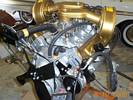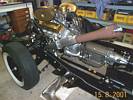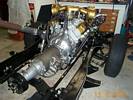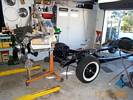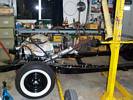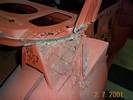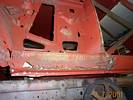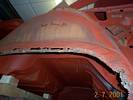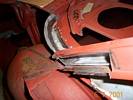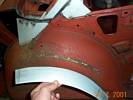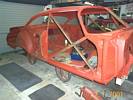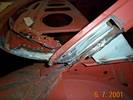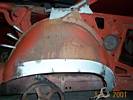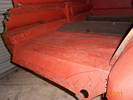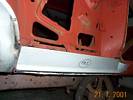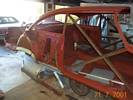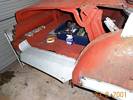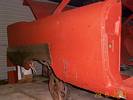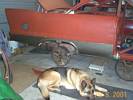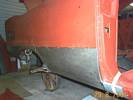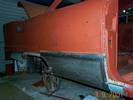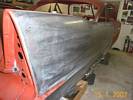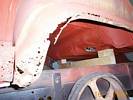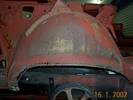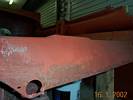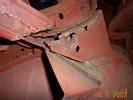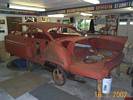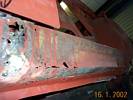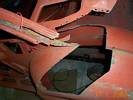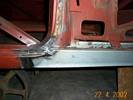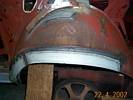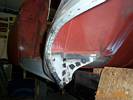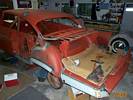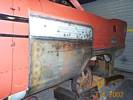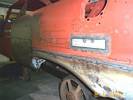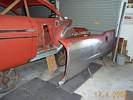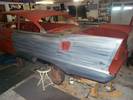
Home | Pics | Christine | Riding the Bullet | Data | History | Links | Wallpaper | Mailing List | '57 Resto | Email me | AIM me
|
Progress of New Zealand's prize Plymouth '57 resto cont'd. While driving my Fury for the previous couple of years, I had been busy in the garage restoring the major running parts which were all incorrect on my Fury. I located and imported a factory engine from out of a 1957 Plymouth Fury, with the correct FP31 engine number. A local machine shop took care of the machining and assembly, and many hours were spent in my garage with the final assembly, accessories, fuel lines, painting, detailing, decals, and sourcing all those little parts which are missing or incorrect when you buy an engine. After giving a local carb shop the job of restoring my dual 4 barrel Cater WCFB’s, they did such a bad job that I was forced to pull them apart and re-restore them myself.
After 2 years of advertising in Hemmings etc, a person phoned me and sold me a 57 Fury 318 engine for $1500 complete with all accessories, carbs, air cleaners and transmission. I shipped it in to New Zealand, and discovered that it was a standard Plymouth 301 with the Fury accessories added, and that somebody had stamped an “F” before the “P-31” on the engine block to make it appear as a Fury serial number, and then went and left the “F” stamp in a little plastic bag on top of the intake for me to find. The following year another person phoned and I purchased the engine that I have now, which had been retired from a factory Fury in 1974, and stored in a barn, and had been kept oiled and turned over ever since.
Due to the condition of the body under all that shiny paint, and evidence that more crusty rust was hidden from view, the decision was made to totally remove the rear quarters. It was a good decision, as these panels can be removed in about 2 hours each by drilling out the spot welds, giving full access to the necessary repair areas. The rust behind the panels was not a pretty sight. Due to no metal protection behind the panel, poor sealing, and built in water traps, it is my belief that most 57-59 MoPars will eventually show these same areas of rust damage, no matter how well they are cared for.
The patch panels that I purchased for the repair of the rusted out lower sections of the rear quarters were, like most patch panels, in need of a lot of work to enable them to fit on to the car. The wheel arch ‘return’ lip under the car was about half an inch too short, and a piece had to be welded on to extend it around the entire wheel arch. The wheel arch swage was not sharp enough and had to be re-worked. The body swage that runs from rear to front was hopeless, so the decision was made to cut the repair panels short of the original swage, and use that instead, which helps to prevent panel distortion spread past the swage during welding. The finished right rear quarter panel is an excellent job, and a fine example of bodywork craftmanship. That weld line between the patchpanels and the original panel is over 92 inches long! With no filler! And is straight as a sheet of glass. Like the right rear quarter panel, the left rear quarter panel was so rusted and beaten up from previous repairs that the entire lower section in front of and behind the rear wheel opening had to be replaced. Some bad rust was discovered behind where the side trim had been sitting on the rear quarter also, and parts of that had to be replaced with new metal. The poorly fitting patch panels needed the same repair work as the right side needed. But when completed, the weld line has practically disappeared.
 
Can you help me locate any of the following parts that I am missing, so that my restoration will proceed through to completion unhindered? You can count on this being current-if a part is on the list then I need it, and you could get to see the part that you supply appear on this page installed onto this very 57 Fury! Fair prices paid for good parts. Any help appreciated. Contact me here. PARTS WANTED For 1957 Plymouth, Fury. Parts colored in green have been found with your help! Shaft to carb linkage, with stud, w/auto 3sp, Fury, Part# 1827-691. (Supplied by Johnny P, Auckland, NZ) Shaft to carb linkage, with slot, w/auto 3sp, Fury, Part# 1822-008. (Missing part turned up) Accelerator pedal lever (what the rubber pedal attaches to) w/auto 3sp, Part# 1734-024. (Supplied by Wendy at glnos@iserv.net) Clips for retaining narrow side stainless mouldings. (Supplied by Ed Sitek, Tolland, Ct.06084) Clips for retaining roof rail stainless mouldings-original-used OK. (supplied by Tim Ridl.) Clips for retaining chrome fin cap mouldings (Supplied by Florida Auto Fastener. 67cayne@gtcom.net. Tony and John.) Clips for retaining stainless moulding that goes directly under trunk lid (Supplied by Florida Auto Fastener. 67cayne@gtcom.net. Tony and John.) Clip that holds windshield washer hose to underside of hood-used OK. (Supplied by John Garofalo, Florida) 6 inch wheel rims (5 needed). Transmission front & lower inspection covers. (2). (Supplied by Tim Ridl, Dickinson, ND 58601) Highway Hi-fi mounting brackets(1957). Highway Hi-fi records. Radiator support to hood bumpers x 2. (Rubber stops with threaded steel). (Supplied by John Garofalo, Florida) Identification tags for carburettors, brass triangular, to suit carbs 2631S & 2632S. (Supplied by Ebay user "Mztercarb.") Fuel pump-Stamped M2501S. (Supplied by Greg Pickens, Ebay user purepony) Ballast resistor, ceramic thing that mounts on coil, want correct one as shown in manual, not later model. Muffler support package-muffler end-dual exhaust, Part # 1843-009 (2) Muffler support & clamp-muffler end-dual exhaust, Part # 1843-008 (2) Exhaust support & clamp-exhaust end-dual exhaust, Part #1843-010 (2) Tail pipe extensions, Part # Clips for retaining chrome hood letters. (Kindly supplied by Louis Guzman from Freeport, New York.) and any NOS parts.  
|
Furyworld v5.0 - Plymouth Run is copyright Lion's Gate Web Services 1999-2004.
